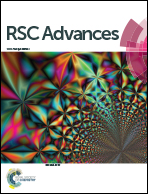Novel TiO2/Sb2S3 heterojunction with whole visible-light response for photoelectrochemical water splitting reactions†
Abstract
Artificial photosynthesis represents a direct approach toward addressing energy and environmental issues by producing fuels such as hydrogen that can be used in fuel cells. Under the framework of Z-scheme water splitting, we develop a composite TiO2 nanorod/Sb2S3 nanooctahedron photoanode, which possesses low onset potential and high photocurrent density. In this work, to mitigate the poor visible light absorption and low quantum efficiency of TiO2, the concept of n/n heterojunction is introduced by using a composite composed of an additional n-type semiconductor and coating it on n-type TiO2 nanorods. A stibnite Sb2S3 is selected as the coating material due to its suitable band-edge position and visible-light response. A photocurrent density of 0.79 mA cm−2 (measured at 1.23 V vs. RHE) and onset potential of −0.08 V vs. RHE are obtained for the photoanode with the TiO2 nanorod/Sb2S3 nanooctahedron structure in a 0.5 M Na2SO4 aqueous solution under AM 1.5G illumination. This successful combination of two n-type semiconductors provides a conceptual blueprint for material and conduction/valence band design as attractive catalysts for the photoelectrochemical water splitting reaction.


 Please wait while we load your content...
Please wait while we load your content...